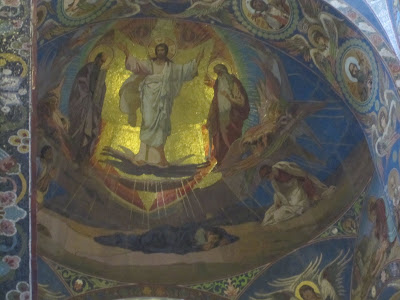In St. Petersburg, Russia we visited what may be my favorite church of all time. It is officially known as the Cathedral of the Resurrection of Christ, but more commonly referred to as the Church of the Savior on Spilled Blood. It is a Russian Orthodox church built on the site where Tsar Alexander II was assassinated on March 13, 1881 by a bomb (the reference to Spilled Blood is to that of Tsar Alexander II's). The church was built by Tsar Alexander III, Alexander II's son, as a memorial. Construction was started in 1883 and completed in 1907 during the reign of Tsar Nicholas II. During the Russian Revolution of 1917, the interior of the church was badly damaged and it was closed in the 1930s when the Bolsheviks were destroying churches all over Russia. During the siege of Leningrad (the name of St. Petersburg during World War II) the church was used as a storage site for corpses. After the war, it was used as a warehouse for vegetables and got the nickname of Savior on Potatoes. In 1970, management of Spilled Blood was turned over to St. Isaac's Cathedral, operating as a profitable museum. Money from the museum was used to restore Spilled Blood and it was reopened in August 1997 after 27 years of restoration work. Spilled Blood now functions primarily as a museum, but occasional services are held there. Spilled Blood intentionally resembles St. Basil's Cathedral in Moscow, another church I love, and it may have more mosaics within it than any other church in the world. We have photos of the side which is the entrance
and the side which is the exit.
The architecture is basically a mirror image, with differences. For example, two of the domes on each side are different. On the entrance side, one dome has smooth gold and blue crosses among pointed squares
and the other has smooth blue and green vertical stripes among pointed squares.
On the exit side, one dome has diagonal smooth blue stripes alternating with diagonal stripes consisting of pointed green and white squares.
The other dome consists of alternating pointed squares and pointed squares within flat squares.
The highest, central dome, has no pointed squares, but is curvy diagonals with alternating colors of green, blue and white.
On the entrance side at roof level is a large mural of the resurrected Christ holding a small cross with an angel at his side.
On the exit side is a similarly placed mural showing the resurrected Christ sitting on his throne.
Above the entrance door is a mural of the hunched over Savior carrying his cross with a Roman soldier behind him.
Above the exit door the similarly placed mural shows the resurrected Savior appearing to his followers.
Murals on structures above the entrance
and exit
are of different saints on each side. Behind the upper murals below the roof are tiles of varying symbols
on each side.
On the end opposite the entrance and exit is a round tower.
Another fun touch on the outside are vertical sections of square tiles with various symbols.
We got a picture of one with the Russian double-headed eagle
and another with a dove.
There are no paintings inside the church. Virtually all the walls and ceilings inside are covered in mosaics,
absolutely wonderful,
amazing mosaics,
that look like paintings
until
you look
at them
up-close.
In classic Russian Orthodox style, almost every surface is covered in icons, more so than other Orthodox churches I've seen and the icons are a little more realistic. If there aren't icons, there may be colorful designs:
and
and
I love the ceilings of the cupolas, some of which are pictured below:
and
and
and
and
and finally, the very center.
The iconostasis, separating the nave from the sanctuary,
has mosaic icons
and focuses our attention on a mosaic of Christ, visible through its open center.
An incredibly beautiful icon case of pink rhodonite, porphyry and jasper
frames a mosaic of the resurrection of Christ.
The floor is covered in various marble tiles, mostly covered to protect it, but the center portion is open to display its splendor.
And then the most unique part of Spilled Blood, the canopy inside that marks the spot where Tsar Alexander II was assassinated.
The area is roped off, but seven steps lead down to the spot where the original street lays uncovered under the canopy still stained with Tsar Alexander's blood. Red roses mark the spot.











































This is one of the few places that elicits an uncontrollable gasp upon entering. Absolutely gorgeous.
ReplyDeleteI can see why this is your favorite church. It is incredible.
ReplyDeleteAs always, very well documented. Interesting place!
ReplyDeleteWe thoroughly enjoyed the wonderment of viewing this historical monument.
ReplyDelete